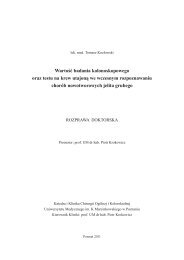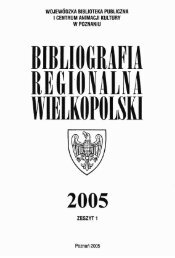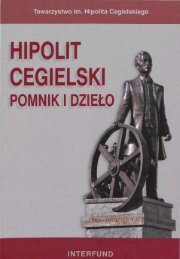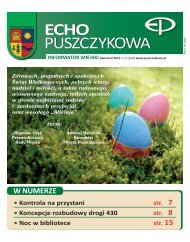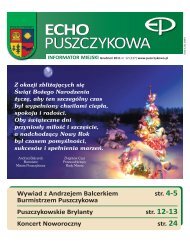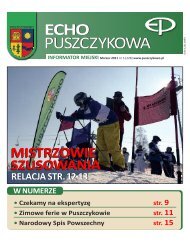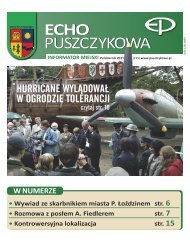© Military Pharmacy and Medicine • 2012 • 4 • 118 – 118References:1. Topolski J. Metodologia historii. PWN; Warszawa 1968.2. Kaczanowski P, Kozłowski K. J. Wielka historiaPolski. Najdawniejsze dzieje ziem polskich. Tom1.Wydawnictwo Fogra; Kraków 1998.3. Piontek J. Biologia populacji pradziejowych.Wydawnictwo Naukowe UAM; Poznań 1999.4. Lisiewicz J. Zagadnienia prehistorii medycyny wświetle antropologii archeologicznej i paleopatologii.Archiwum Historii i Filozofii Medycyny. 1970;33:145-161.5. Wierzbicka D. Zagadnienia paleomedycyny na Śląsku.Prace Medyczne 1977-1978. Opolskie TowarzystwoPrzyjaciół Nauk. Wydział Nauk Medycznych. 1980: 5.6. Gryglewski W. R. Paleopatologia w badaniachhistoryka medycyny. In: Meissner R, editor. Medycynai farmacja XIX i XX wieku; Poznań 2007.7. Malinowski A. Zmienność chorób zębów umieszkańców ziem polskich w przeszłości. ArchiwumHistorii i Filozofii Medycyny. 1979; 42: 463.8. Gładykowska-Rzeczycka J. Lecznictwo u Słowian.Sztuka i Medycyna. 1993; 3(1): 4-5.9. Biegeleisen H. Lecznictwo ludu polskiego. PAU;Kraków 1929.10. 10. Latałowa M, Jarosińska J, Badura M. Elblągśredniowieczny w świetle dotychczasowychmateriałów archeobotanicznych. Archeologia Polski.1998; 43: 145-166.11. 11. Zemanek A, Wasylikowa K. Historia botanikii archeobotanika w poszukiwaniu danych oużytkowaniu roślin w średniowiecznym Krakowie.Analecta. Studia i materiały z dziejów nauki. 1996;5:123-138.12. Badura M, Latałowa M, Jarosińska J, Święta J. Roślinyużytkowe w średniowiecznych i nowożytnychmateriałach archeobotanicznych z miast północnejPolski (Kołobrzeg, Gdańsk, Elbląg). In: Czaia R,editor. Archaeologia et Historia Urbana; Elbląg 2004.13. Brongers JA. Ancient Old-World TrepanningInstruments. Berichten ven de Rijksdienst voor hetOudheidkundig Bodemonderzoek. 1969; 19: 7-16.14. Woźniak Z. Celtowie w Polsce. PWN; Kraków 1968.15. Kirkup J. The evolution of the surgical instrumentsfrom ancient times to the twentieth century. NormanPublishing. California 2006.16. Gładykowska-Rzeczycka J. Schorzenia swoisteludności z dawnych cmentarzysk Polski. PrzeglądAntropologiczny. 1982; 48: 44.17. Gładykowska-Rzeczycka J. Schorzenia ludnościprahistorycznej na ziemiach polskich. Gdańsk 1989.Review article18. Kwiatkowska B. Mieszkańcy średniowiecznegoWrocławia. Ocena warunków życia i stan zdrowiaw ujęciu antropologicznym. WydawnictwoUniwersytetu Wrocławskiego; Wrocław 2005.19. Tubbs SR, Salter GE, Oakes JW. Artificial deformationof the human skull: a review. Clinical Anatomy. 2006;19: 372-377.20. Jankowski J. Historia medycyny średniowiecznejw Polsce. Człowiek, populacja, środowisko. PraceDolnośląskiego Centrum Diagnostyki MedycznejDolmed we Wrocławiu. Wrocław 1988.21. Mazurowski W, Ząbek M. Neurochirurgia. In:Bielecki K, editor. Narzędzia, protezy i szwychirurgiczne; Warszawa 1995.22. Strona internetowa http://global.sbs.ohio-state.eduGlobal History of Health Project23. Mariani-Costantini R, Catalano P, di Gennaro F, diTota G, Angeletti LR. New light on cranial surgery inancient Rome. Lancet. 2000; 22(355): 305-307.24. Chmurzyńska A, Kantor I, Jurkiewicz D. Urazy kościskroniowej. Lekarz Wojskowy. 1999; 75(3-4):173.25. Andrzejowski J, Stanaszek ŁM, Mańkowska-PliszkaH. Modła, grób 169-pierwsza trepanacja czaszkiz okresu wpływów rzymskich z ziem polskich.Wiadomości Archeologiczne. 2006; 48: 185-199.26. Żukiel R, Jankowski R, Stachowska-TomczakB, Blok T, Wieloch M. Operacyjne leczenieurazów czaszkowo-mózgowych w Ameryceprzedkolumbijskiej. Neuroskop. 2001; 1(3): 74.27. Paluch A. Ślady występowania zabiegówtrepanacyjnych na ziemiach Polski i Czechosłowacjiw starożytności i średniowieczu. Archeologia Polski.1975; 20: 411-454.28. Piek J, Lidke G, Terberger T, Von Smekal U, Gaab MR.Stone Age surgery in Macklenburg-Vorpommern: asystematic study. Neurosurgery. 1999; 45: 147-151.29. Biborski M. Dalsze ratownicze badaniawykopaliskowe na cmentarzysku kultury przeworskiejz późnego okresu wpływów rzymskich i wczesnejfazy wędrówek ludów w Mokrej, woj. śląskie. Badaniaarcheologiczne na Górnym Śląsku i ziemiachpogranicza w latach 2001-2002; Katowice 2004:125-130.30. Demidziuk K, Kokowski A. Żukowice, pow.Głogowski, woj. dolnośląskie, grób 41. In:Wandalowie strażnicy bursztynowego szlaku. Lublin-Warszawa 2004, s.290.31. Półtorak Z., Lecznictwo ludowe rodzinnej ludnościOpolszczyzny. Instytut Śląski; Opole 1989.32. Sokół S. Historia chirurgii w Polsce. Cz. 1. Chirurgiaokresu cechowego. Wydawnictwo PAN; Wrocław 1967.118 http://military.isl-journals.com
© Military Pharmacy and Medicine • 2012 • 4 • 119 – 122Radosław Ziemba: Bioterrorism — nature of the problemEmergency medicineBioterrorism — nature of the problemRadosław ZiembaMilitary Centre for Pharmacy and Medical Technology in Celestynow, PolandAuthor’s address:Radosław Ziemba, Military Centre of Pharmacy and Medical Technique, ul. Wojska Polskiego 57,05–430 Celestynów, Poland; e–mail: zx11@op.plReceived: 2012.07.12 • Accepted: 2012.11.22 • Published: 2012.12.08Summary:In the 20h century, terrorism became a threat to international safety. Over the past 100 years, terrorismbecame transformed and became a factor to a large extent determining the sphere of political, economicaland social relations on local, regional and international levels. Advancing globalization and accompanyingprogress in the field of IT and telecommunication technologies facilitated emergence of newforms of this phenomenon and widening of its spatial scope.Key words: terrorism, biological weapons, biological weapons development programs.We should seek the genesis and beginnings ofbioterrorism much earlier, although all forms ofits employment fall, in a more intense shape, atthe turn of the 20th and 21st century. Its issues,essence and nature should rather be combinedwith, rather than detached from, generally understoodterrorism. Experts on the issue associatethis phenomenon, which is now widespread andconsidered one of the main global problems, witha symptom of “degeneration of war.” A growingnumber of civilian casualties constitute its illustration.Degeneration of war is accompanied bya tendency described by Boleslaw Balcerowicz as“lowering of war threshold” [1]. It is an inclinationtoward conducting warfare against a populationof people completely uninvolved, intentionallyat least, in any military conflict. Such actionsare called “quasi wars” and their toll is based onthe lack or low level of awareness among civilianpopulation in a given region, city or territory of agiven country. Destructive actions are no longerreserved for states, as main players in internationalrelations and subjects of internationalpublic law. Suitably prosperous, although poorlyhttp://military.isl-journals.comarmed ideologist or even an ideological maniacplaying on fanaticism can evoke a conflict on aninternational scale. With that, he can perform adetonation not only in its mechanical sense, butalso detonate the sense of common, individualand personal safety and introduce a broadlydefined psychosis of fear.Despite multiple publications on terrorism, it is difficultto establish a uniform definition of this phenomenon.It should be noted that there are abouttwo hundred expressions in the whole literature.Phonetically, it is almost identical in all Europeanlanguages and therefore, understood by everyone(fr. terrorisme, sp. terrorismo, rus. terrorizm).Two definitions should be mentioned in relationto the problem of bioterrorism as an acceptedfaçade of broadly defined terrorism. One of themis taken from an encyclopedia (published byPWN in Warsaw in 1993, page 864), defining terrorismas: “ an activity of small extremist groupsthat, through murder, death threats, politicalmurders, kidnapping of hostages or planes and119



